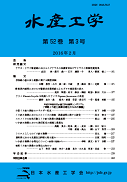38 巻, 1 号
選択された号の論文の11件中1~11を表示しています
- |<
- <
- 1
- >
- >|
-
2001 年 38 巻 1 号 p. 1-8
発行日: 2001年
公開日: 2018/06/01
PDF形式でダウンロード (1346K) -
2001 年 38 巻 1 号 p. 9-18
発行日: 2001年
公開日: 2018/06/01
PDF形式でダウンロード (1238K) -
2001 年 38 巻 1 号 p. 19-24
発行日: 2001年
公開日: 2018/06/01
PDF形式でダウンロード (998K) -
2001 年 38 巻 1 号 p. 25-34
発行日: 2001年
公開日: 2018/06/01
PDF形式でダウンロード (2946K) -
2001 年 38 巻 1 号 p. 35-42
発行日: 2001年
公開日: 2018/06/01
PDF形式でダウンロード (1487K) -
2001 年 38 巻 1 号 p. 43-51
発行日: 2001年
公開日: 2018/06/01
PDF形式でダウンロード (1570K) -
2001 年 38 巻 1 号 p. 53-59
発行日: 2001年
公開日: 2018/06/01
PDF形式でダウンロード (1083K) -
2001 年 38 巻 1 号 p. 61-68
発行日: 2001年
公開日: 2018/06/01
PDF形式でダウンロード (1768K) -
2001 年 38 巻 1 号 p. 69-77
発行日: 2001年
公開日: 2018/06/01
PDF形式でダウンロード (1686K) -
2001 年 38 巻 1 号 p. 79-90
発行日: 2001年
公開日: 2018/06/01
PDF形式でダウンロード (2364K) -
2001 年 38 巻 1 号 p. 91-102
発行日: 2001年
公開日: 2018/06/01
PDF形式でダウンロード (2230K)
- |<
- <
- 1
- >
- >|
